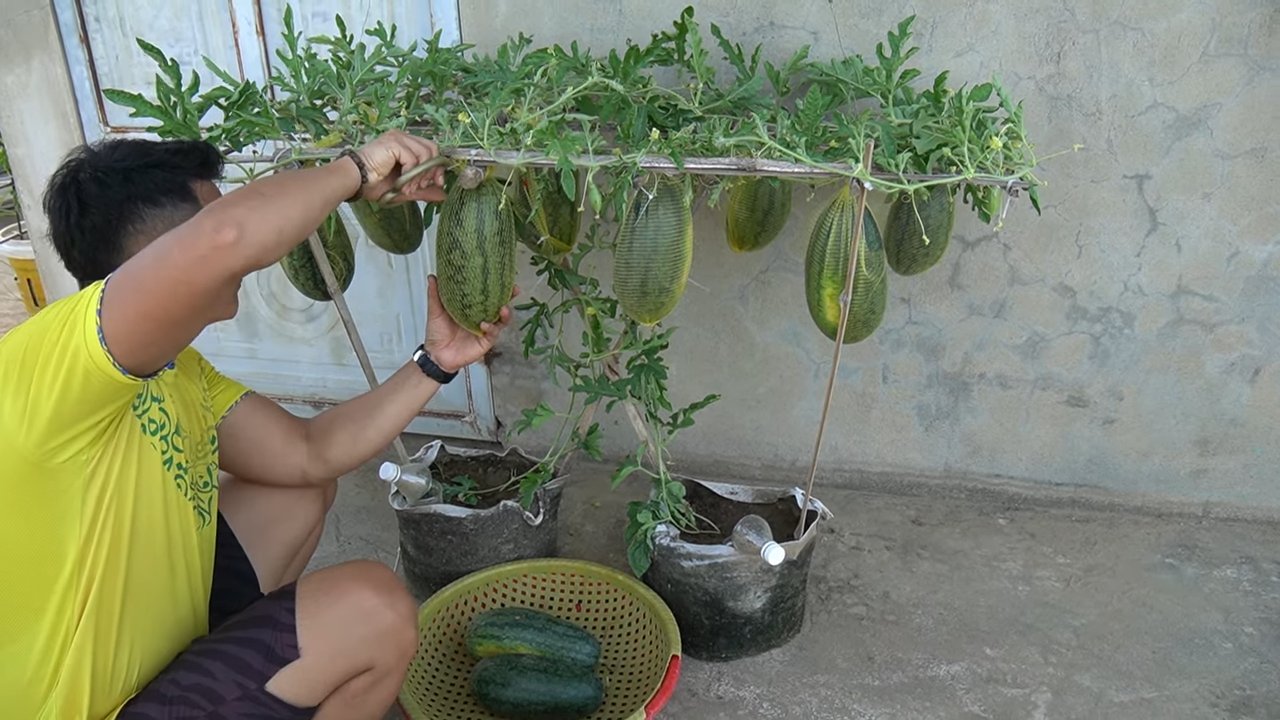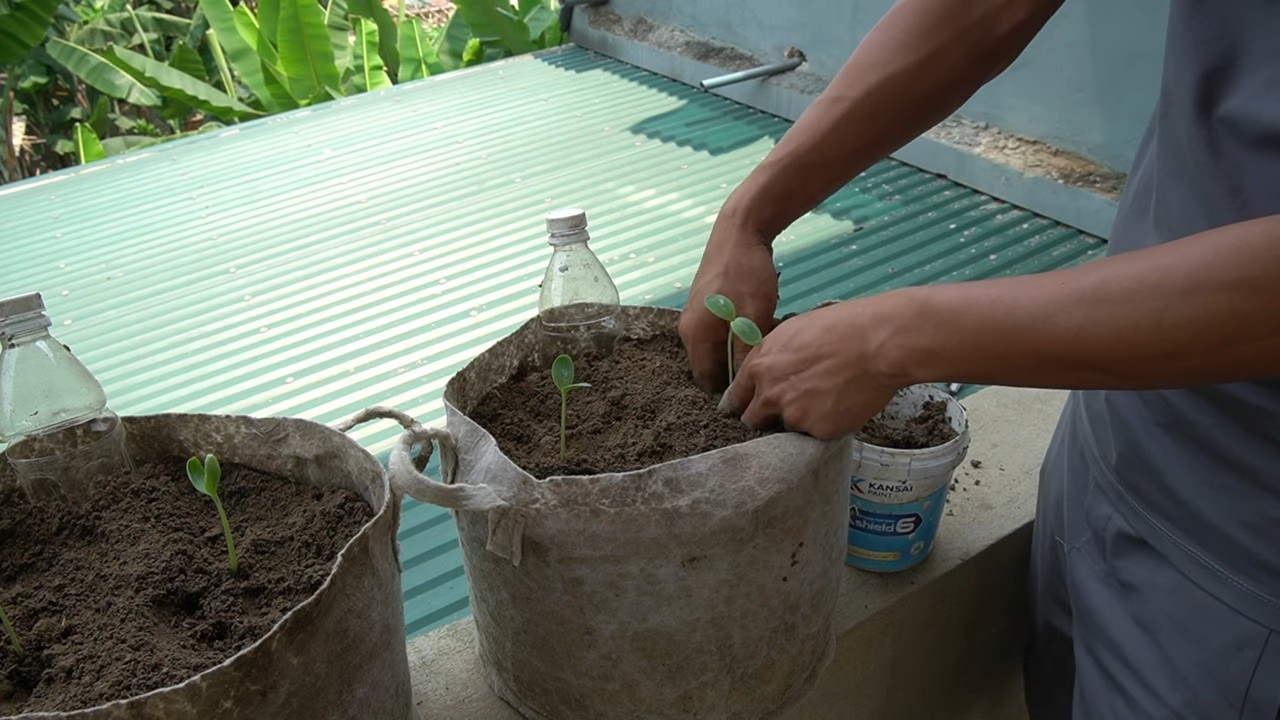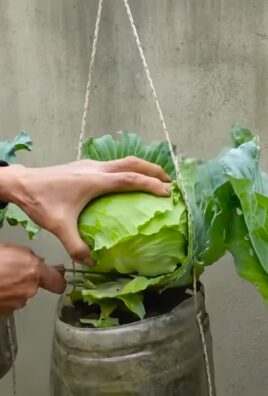Container Watermelon Growing: Imagine biting into a juicy, sweet watermelon you grew yourself, right on your patio! Sounds impossible? Think again! For centuries, watermelons have been a symbol of summer, abundance, and shared joy, gracing tables from ancient Egypt to modern-day picnics. But what if you don’t have acres of farmland? That’s where the magic of container gardening comes in.
I know what you’re thinking: watermelons are huge! And you’re right, they can be. But with the right techniques and a little DIY ingenuity, you can absolutely cultivate these delicious fruits in containers, even in small spaces. This article is your ultimate guide to unlocking the secrets of container watermelon growing. We’ll explore everything from choosing the perfect variety and container size to mastering watering and fertilization.
Why is this DIY trick so essential? Because everyone deserves the satisfaction of harvesting their own food, regardless of their living situation. Plus, growing your own watermelons means you control what goes into them, ensuring a healthy and delicious treat free from harmful pesticides. So, ditch the store-bought melons and get ready to embark on a rewarding journey of growing your own sweet slice of summer, right in your backyard (or balcony!). Let’s get started!

Growing Watermelons in Containers: A Step-by-Step Guide
Hey there, fellow gardening enthusiasts! Ever dreamt of biting into a juicy, homegrown watermelon but thought you didn’t have the space? Well, I’m here to tell you that you absolutely can grow watermelons, even if you only have a balcony or patio! It’s all about container gardening, and I’m going to walk you through everything you need to know. Get ready to impress your friends and family with your watermelon-growing prowess!
Choosing the Right Watermelon Variety
First things first, not all watermelons are created equal when it comes to container gardening. You’ll want to choose a bush or dwarf variety that’s specifically bred for smaller spaces. These varieties are more compact and produce smaller fruits, making them perfect for containers.
Here are a few of my favorite container-friendly watermelon varieties:
* Sugar Baby: This is a classic choice! It produces small, round watermelons that are incredibly sweet and mature quickly.
* Bush Sugar Baby: As the name suggests, this is a bushier version of the Sugar Baby, making it even more suitable for containers.
* Golden Midget: This variety produces small, yellow-skinned watermelons that are just as delicious as their red-fleshed counterparts.
* Tiger Baby: A unique variety with striped skin and a sweet, crisp flavor. It’s also relatively compact.
* ‘Patio Baby’ Hybrid Watermelon: This is a newer hybrid specifically bred for small spaces and containers.
Gathering Your Supplies
Okay, now that you’ve chosen your watermelon variety, let’s gather the supplies you’ll need. This is where the fun begins!
* Large Container: This is crucial! Watermelons need plenty of space for their roots to grow. I recommend a container that’s at least 24 inches in diameter and 24 inches deep. The bigger, the better, honestly. A half wine barrel or a large, sturdy plastic container will work great.
* High-Quality Potting Mix: Don’t skimp on the potting mix! You’ll need a well-draining mix that’s rich in organic matter. Avoid using garden soil, as it can become compacted in containers and hinder drainage. I like to use a mix of compost, peat moss (or coco coir), and perlite.
* Water-Soluble Fertilizer: Watermelons are heavy feeders, so you’ll need to fertilize them regularly. Choose a water-soluble fertilizer that’s specifically formulated for fruits and vegetables. Look for a balanced fertilizer with a slightly higher phosphorus content (the middle number on the fertilizer label) to promote fruit development.
* Trellis or Support System: Even bush varieties can get a bit sprawling, so a trellis or support system will help keep the vines off the ground and prevent the fruits from rotting. A tomato cage, a small trellis, or even a sturdy stake will do the trick.
* Watering Can or Hose: You’ll need a way to water your watermelons regularly. A watering can with a gentle rose head is ideal, but a hose with a spray nozzle will also work.
* Seeds or Seedlings: Of course, you’ll need watermelon seeds or seedlings! You can start your own seeds indoors a few weeks before the last frost, or you can purchase seedlings from a local nursery.
* Gardening Gloves: Protect your hands from dirt and thorns with a pair of gardening gloves.
* Mulch: Mulch helps retain moisture in the soil, suppress weeds, and regulate soil temperature. I like to use straw or shredded bark.
Planting Your Watermelon
Alright, let’s get our hands dirty! Here’s how to plant your watermelon in a container:
1. Prepare the Container: Make sure your container has drainage holes. If not, drill some! Then, fill the container with your high-quality potting mix, leaving a few inches of space at the top.
2. Plant the Seeds or Seedlings: If you’re starting from seeds, sow them directly into the container, about 1 inch deep. If you’re using seedlings, gently remove them from their pots and plant them in the center of the container, making sure the top of the root ball is level with the soil surface.
3. Water Thoroughly: After planting, water the container thoroughly until the water drains out of the bottom. This will help settle the soil and get the roots off to a good start.
4. Add Mulch: Spread a layer of mulch around the base of the plant to help retain moisture and suppress weeds.
5. Provide Support: Install your trellis or support system now, before the vines start to grow. This will make it easier to train the vines as they develop.
Caring for Your Container Watermelon
Now that your watermelon is planted, it’s time to provide it with the care it needs to thrive.
1. Watering: Watermelons need consistent moisture, especially during hot weather. Water deeply whenever the top inch of soil feels dry to the touch. Avoid overwatering, as this can lead to root rot. I usually water every other day, but it depends on the weather.
2. Fertilizing: As I mentioned earlier, watermelons are heavy feeders. Fertilize them every two weeks with a water-soluble fertilizer, following the instructions on the package. During fruit development, you can switch to a fertilizer with a higher potassium content (the last number on the fertilizer label) to promote sweeter fruits.
3. Sunlight: Watermelons need at least 6-8 hours of sunlight per day. Place your container in a sunny location where it will receive plenty of direct sunlight.
4. Pruning: While you don’t need to prune bush varieties extensively, you can remove any dead or yellowing leaves to improve air circulation. You can also pinch off any side shoots that are growing too aggressively to encourage the plant to focus its energy on fruit production.
5. Pollination: Watermelons need to be pollinated in order to produce fruit. If you’re growing your watermelons outdoors, bees and other pollinators will usually take care of this for you. However, if you’re growing them indoors or in a location with limited pollinator activity, you may need to hand-pollinate them. To hand-pollinate, use a small paintbrush to transfer pollen from the male flowers (which have a long, thin stem) to the female flowers (which have a small, immature watermelon at the base).
6. Supporting the Fruit: As your watermelons grow, they may become too heavy for the vines to support. You can use slings made from pantyhose or netting to support the fruits and prevent them from breaking off the vine.
7. Pest and Disease Control: Keep an eye out for common watermelon pests, such as aphids, squash bugs, and cucumber beetles. You can control these pests with insecticidal soap or neem oil. Watermelons are also susceptible to fungal diseases, such as powdery mildew and anthracnose. To prevent these diseases, provide good air circulation, avoid overhead watering, and apply a fungicide if necessary.
Harvesting Your Watermelon
The moment you’ve been waiting for! Harvesting your homegrown watermelon is one of the most rewarding experiences a gardener can have.
1. Check the Tendril: The tendril closest to the watermelon stem will turn brown and dry when the fruit is ripe.
2. Thump the Watermelon: A ripe watermelon will have a deep, hollow sound when you thump it.
3. Check the Ground Spot: The spot where the watermelon rests on the ground will turn from white to yellow when the fruit is ripe.
4. Harvest Carefully: Use a sharp knife or pruning shears to cut the watermelon from the vine, leaving a few inches of stem attached.
Troubleshooting Common Problems
Even with the best care, you may encounter some problems while growing watermelons in containers. Here are a few common issues and how to address them:
* Yellowing Leaves: This can be caused by overwatering, underwatering, nutrient deficiencies, or pests. Check the soil moisture, fertilize regularly, and inspect the plant for pests.
* Blossom End Rot: This is a common problem that causes the bottom of the watermelon to rot. It’s usually caused by calcium deficiency. To prevent blossom end rot, add calcium to the soil before planting and water consistently.
* Lack of Fruit: This can be caused by poor pollination, nutrient deficiencies, or stress. Hand-pollinate the flowers, fertilize regularly, and provide adequate water and sunlight.
* Small Fruits: This can be caused by insufficient sunlight, water, or nutrients. Make sure your watermelon is getting at least 6-8 hours of sunlight per day, water it regularly, and fertilize it every two weeks.
Enjoying Your Homegrown Watermelon
Congratulations! You’ve successfully grown a watermelon in a container. Now it’s time to enjoy the fruits (literally

Conclusion
So, there you have it! Growing your own watermelons in containers isn’t just a fun gardening project; it’s a surprisingly accessible way to enjoy the sweet taste of summer, even if you’re short on space. We’ve walked through the steps, from selecting the right variety and container to nurturing your plant for optimal growth. The beauty of this DIY trick lies in its adaptability. It’s not just about following a rigid set of rules, but about understanding the needs of your watermelon plant and tailoring your approach accordingly.
Why is this a must-try? Because the satisfaction of harvesting a juicy, homegrown watermelon from your own container is unparalleled. It’s a testament to your green thumb, a delicious reward for your efforts, and a conversation starter for anyone who visits your home. Plus, you have complete control over the growing process, ensuring your watermelon is free from unwanted chemicals and pesticides. You know exactly what went into it, making each bite even more enjoyable.
But the journey doesn’t end here! Feel free to experiment with different watermelon varieties. Perhaps you’d like to try a smaller, personal-sized watermelon like ‘Sugar Baby’ or a yellow-fleshed variety for a unique twist. Consider adding companion plants like marigolds or basil to your container to deter pests and attract beneficial insects. You could even try vertical gardening techniques, training your watermelon vine to climb a trellis for a visually stunning display. The possibilities are endless!
Don’t be intimidated by the thought of growing watermelons in containers. It’s a rewarding experience that brings a touch of summer magic to any space. The key is to start with the right information, provide consistent care, and be patient. Remember to monitor your plant regularly, adjust your watering schedule as needed, and provide adequate support for the developing fruit.
We’re confident that with a little effort and attention, you’ll be enjoying your own homegrown watermelons in no time. So, grab your seeds, choose your container, and get ready to embark on this exciting gardening adventure. We encourage you to try this DIY trick and discover the joy of growing your own delicious watermelons.
And most importantly, we want to hear about your experience! Share your photos, tips, and challenges in the comments below. Let’s create a community of container watermelon growers and learn from each other. What variety did you choose? What challenges did you face? What tips did you discover along the way? Your insights could help other aspiring gardeners achieve their watermelon-growing dreams. Let’s spread the watermelon love and inspire others to embrace the joy of homegrown goodness! We can’t wait to see your container watermelon growing success stories!
Frequently Asked Questions (FAQ)
What is the best size container for growing watermelons?
The ideal container size for growing watermelons is at least 20 gallons, but larger is always better. A half-barrel container or a large, sturdy plastic tub works well. The key is to provide ample space for the roots to develop and support the weight of the mature fruit. Smaller containers can restrict root growth, leading to smaller watermelons or even plant failure. Ensure the container has adequate drainage holes to prevent waterlogging.
What type of soil should I use for container watermelon growing?
Use a high-quality potting mix that is well-draining and rich in organic matter. Avoid using garden soil, as it can become compacted in containers and hinder root growth. A good potting mix will retain moisture while allowing excess water to drain away, preventing root rot. You can also amend the potting mix with compost or aged manure to provide additional nutrients.
How often should I water my container watermelon plant?
Watermelon plants need consistent moisture, especially during hot weather and when the fruit is developing. Water deeply whenever the top inch of soil feels dry to the touch. This may mean watering daily or even twice a day during peak summer months. Avoid overhead watering, as it can promote fungal diseases. Instead, water at the base of the plant, directing the water towards the roots.
How much sunlight do watermelons need?
Watermelons require at least 6-8 hours of direct sunlight per day to thrive. Choose a location that receives full sun for optimal growth and fruit production. If you live in a particularly hot climate, providing some afternoon shade can help prevent the plant from overheating.
Do I need to fertilize my container watermelon plant?
Yes, watermelons are heavy feeders and require regular fertilization. Use a balanced fertilizer (e.g., 10-10-10) at planting time and then switch to a fertilizer higher in phosphorus and potassium (e.g., 5-10-10) once the plant begins to flower. Fertilize every 2-3 weeks throughout the growing season, following the instructions on the fertilizer label.
How do I pollinate my watermelon flowers?
Watermelons have separate male and female flowers. Bees and other pollinators typically handle pollination, but if you’re growing watermelons indoors or in an area with limited pollinators, you may need to hand-pollinate. To hand-pollinate, use a small paintbrush to transfer pollen from the male flower to the female flower. The female flower has a small, immature watermelon at its base.
How do I know when my watermelon is ripe?
There are several indicators of watermelon ripeness. The tendril closest to the fruit should be brown and dry. The underside of the watermelon (where it rests on the ground) should be yellow or cream-colored. When you thump the watermelon, it should sound hollow and deep. These are all good signs that your watermelon is ready to harvest.
What are some common pests and diseases that affect watermelons?
Common pests include aphids, squash bugs, and vine borers. Common diseases include powdery mildew and fusarium wilt. Monitor your plant regularly for signs of pests or diseases and take action promptly. Use organic pest control methods such as insecticidal soap or neem oil. Ensure good air circulation to prevent fungal diseases.
Can I grow multiple watermelon plants in one container?
It’s generally best to grow only one watermelon plant per container, especially if you’re using a smaller container. Multiple plants can compete for resources, leading to smaller watermelons or reduced yields. If you have a very large container (e.g., a half-barrel), you may be able to grow two plants, but be sure to provide adequate space and nutrients for both.
How do I support the weight of the watermelon fruit?
As the watermelon fruit grows, it can become quite heavy and may need support to prevent the vine from breaking. You can use a sling made from pantyhose or burlap to support the fruit. Tie the sling to a sturdy support structure, such as a trellis or stake. This will help distribute the weight of the watermelon and prevent it from falling off the vine.




Leave a Comment